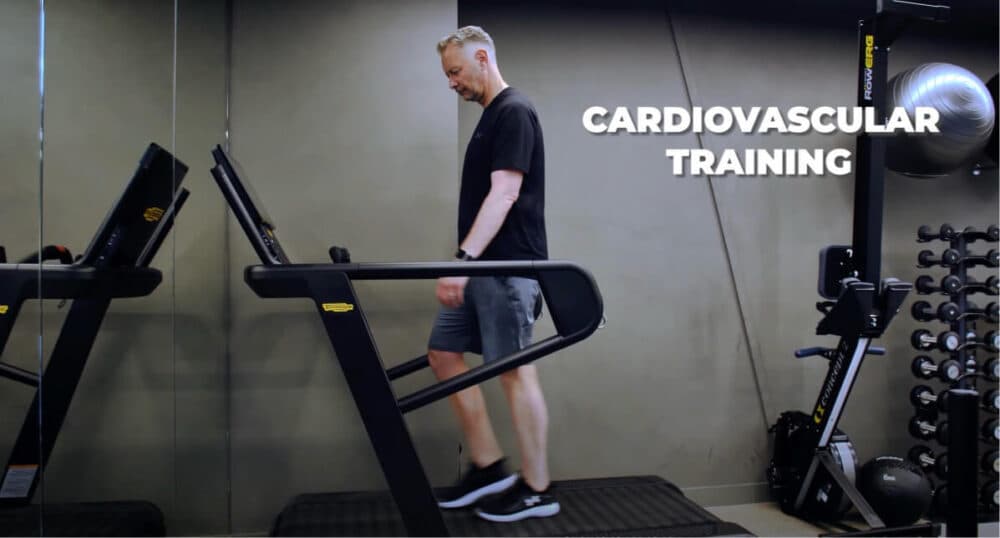8th November 2024
Physiotherapists top tips on how to overcome knee pain to "Move Freely Live Fully"
Is knee pain holding you back from exercising? It’s thought that over 5 million people in the UK1 have knee osteoarthritis (OA), which can cause daily discomfort and limit mobility. This degenerative condition can mean it’s daunting for people to start and maintain an exercise programme. But leading physiotherapists Charlie Goodchild and Nick Guth are here to tell us of the benefits of a carefully planned rehab programme and have devised a NEW online video series to boost your confidence in hitting the gym or working out at home - commissioned by Contura Orthopaedics Ltd, who are redefining treatment for knee osteoarthritis (OA) - without the need for surgery.

Charlie Goodchild, physiotherapist and co-creator of the exercise rehab plan, from healthcare business Better explains, “Knee osteoarthritis can’t be cured, but with a long-term commitment to exercise, there is a better chance of living a more active life that is less affected by knee pain. Deciding what to do to help manage knee OA can be difficult – but one thing is certain, exercise is proven to help strengthen muscles and support joints. Movement is good for everybody, at any stage of arthritis. The key is to choose exercise best suited to your current abilities”
Here are Charlie & Nick’s top tips – “The Five Cs” for approaching a rehab exercise programme:

Come to terms with your diagnosis
Knee OA can be a difficult diagnosis to accept, with the constant pain disrupting sleep, affecting daily movement and for some people, limiting participation in more extreme or intense team sports and activities such as skiing. For people who have always been active, this limited mobility, and persistent pain can be frustrating and start to affect mental health. There’s a common misconception that you should protect and rest arthritic joints. What this leads to is the breaking down and weakening of muscles, tendons, and cartilage. If you don’t use it, you lose it! The truth is that movement is good for everybody at any stage of arthritis. The key is to choose an exercise that is best suited to your current abilities and crucially to follow a plan that has been created by a specialist with a good understanding of how the joints work and respond to exercise. By focusing on the fundamentals of good posture and safe and sustained movement, over time people can build the foundations of a stronger body to help regain confidence in exercise.
Confidence
Sustaining an injury or experiencing a deterioration in debilitating knee OA symptoms can come as a real blow to many people, affecting self-esteem as well as causing physical pain. For many people, it can signal a loss of freedom and independence and time out from exercise, or the gym and can cause you to lose confidence. Following a well-planned and medically researched programme can help to build back that confidence, knowing that you will gradually improve over time if you can stick to the regime. To provide additional reassurance, we’ve designed a questionnaire to help you identify the right level for you; Early Stage, Intermediate and Advanced.

Each programme gives a video “explainer” with a filmed demo of each exercise – such as “Sit to Stand”, “Split Squat” and “Single Leg Glute Bridge”, as well as guidance on cardiovascular training to include rowing, cycling and walking and using equipment such as the treadmill, where available. For example, on the early-stage plan, the advice is to aim for 150 minutes of moderate-intensity cardiovascular activity per week.
If you’re feeling self-conscious about going to the gym, please don’t worry about what other people will think. People of all ages and abilities use the gym now and you will gain confidence from following the videos on your phone or device as you exercise. If you don’t have access to a gym, you can also easily follow the plan at home or on holiday, meaning you can consistently “show up” to increase the chances of improvements over time.

Consistency
This is key. With exercise, you get out what you put in. These plans are designed to be adaptable for all levels, so you will build up strength gradually. But you do need to be consistent to see the results. The aim is for you to make these exercises a part of your weekly routine in the long term. If you’re struggling to find time or motivation, it can help to block out time in your diary. Some people also find it helpful to tell friends and family about their new exercise rehab plan or even share it on social media to increase “accountability”.
Check-ins
It’s important to keep track of your progress – not only is it motivating to chart an improvement in strength, but it’s also wise to note any change in symptoms. Try keeping a diary of your exercise programme and jot down notes each week – for example, did you experience any pain or soreness, how are you sleeping, did you find any of the exercises difficult or awkward? If you have any concerns or questions, seek advice from a qualified health care professional such as a physiotherapist, a sports and exercise medicine consultant or an orthopaedic surgeon who can give medical advice on managing your knee OA symptoms and help individualise the exercises to your needs and capabilities.
Consider treatment
Every person’s journey with knee OA is different - for some, pain is low-level and can be managed daily. However, over time symptoms can progress and persist, and many people need to consider treatment to try to make improvements to their quality of life. Until very recently, one of the only long-term pain relief options was knee replacement surgery, requiring overnight hospital treatment and a long, slow recovery period. Now, more innovative solutions like Arthrosamid®, is available to help relieve the pain caused by knee OA. It is a cutting-edge injectable hydrogel, that is administered via a simple, one-step procedure – ensuring you are in and out of the clinic the same day.2 It is the first and only approved injectable treatment that is permanent4 and is proven to maintain a significant, long-lasting3,5 reduction in knee OA pain – even 4 years post-treatment. 5
In our expert opinion, injections are best paired with an exercise plan, and the pain relief provided gives a window of opportunity to improve the health of the joints. We’re passionate about educating patients on the power of exercise to strengthen and support the knee and to bring a better range of movement and mobility throughout the whole body.
This new programme can be used before or after treatment to help support your prehab, rehabilitation or recovery journey to enable you to get back to the regular exercise you love. Each person will require a different dose of exercise to achieve optimal results. It requires just the right amount of difficulty so that you fatigue your tissues, which triggers an adaptive response within your body which strengthens the tissues and helps them cope better the next time.
More information
For more information on knee osteoarthritis, and treatment options or to start the rehabilitation programme or download a brochure, please click one of the links below.
References:
1.Versus Arthritis: 2023 State of MSK Health Report.
2. Arthrosamid®, Instructions For Use (IFU) Release Date March 2022. 10082-003.
3. Bliddal, H., et al. (2024) 3-year follow-up from a randomized controlled trial of intra-articular polyacrylamide hydrogel injection in subjects with knee osteoarthritis. Poster LB-31, OARSI 2024 World Congress on Osteoarthritis.
4. Christensen, L., et al. (2016). Histological Appearance of the Synovial Membrane after Treatment of Knee Osteoarthritis with Polyacrylamide Gel Injections: A Case Report. Journal of Arthritis. Vol 5: 217.
5Bliddal, H., et al. (2024) A Prospective Study of Polyacrylamide Hydrogel Injection for Knee Osteoarthritis: Results From 4 Years After Treatment. Presented at EORS 2024, Aalborg and Orthopaedic Proceedings of the Bone & Joint Journal.
OUS/ARTHRO/NOV2024/273
